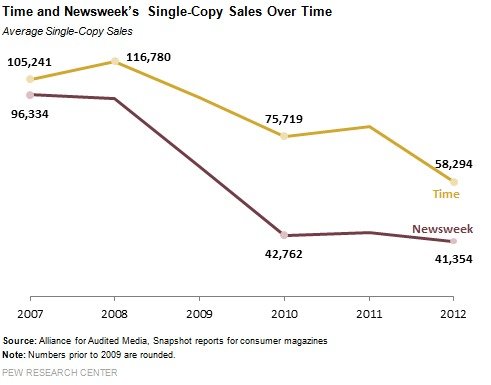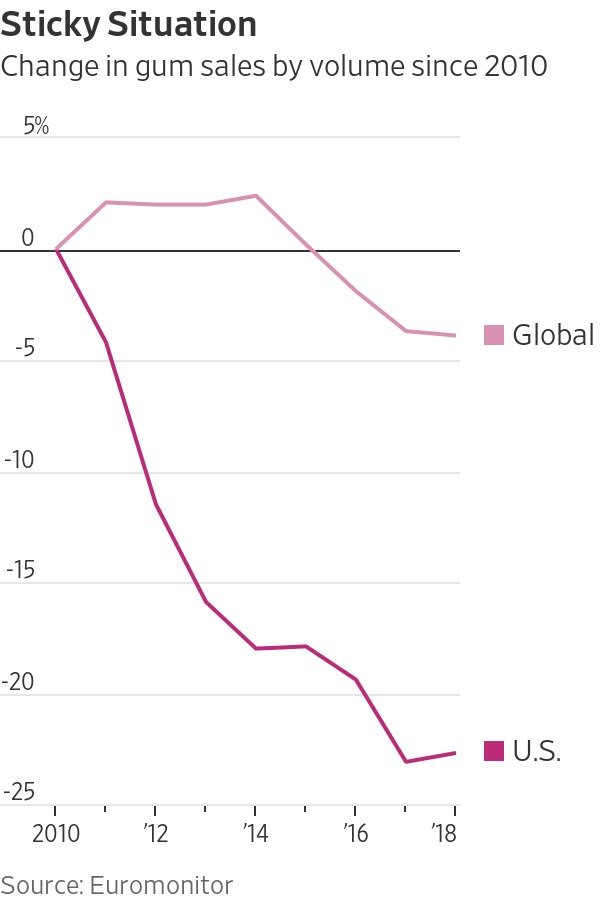Are smartphones making our breath worse? And TWO reposts!
My favorite takeaway from my first Digital Marketing class related to chewing gum. Our teacher, Yanay Sela, showed us the graph above, without the title, clearly depicting a decline in gum sales around 2008. This isn’t to say “Big Gum” is suffering hard, but rather that they’re seeing deminishing sales and reversing trends. Professor Sela asked the class why this trend may have started. Minds raced, leading to varying answers from worse marketing campaigns, the creation of Facebook (I’m not sure the connection) and more loosely connected vectors. Ultimately, Professor Sela mentioned the rise in smart phones as the driving factor.
Smart phones are today associated with on-screen keyboards. I started using a (modified) iPhone 3G in 2008, mostly for a Gameboy emulator. But I was an early adopter. Most remember, Sidekicks and other QWERTY-keyboard devices were still trying to compete with the new iPhones and Galaxy smartphones in 2008. It was clear the Blackberry trend had died off, ridden with lawsuits and an inferior UX. Yet I distinctly remember people holding onto their less-intelligent smart phones until 2010. Around 2010 it really felt the world gave up and embraced our smartphone overlords. I mention this anecdote to posit it may not have been the smart phones themselves, but rather the tech addiction which caused the decline in gum sales. Or maybe it was smart phones, and the trend of smart phone adoption correlates inversely with the trend above. Who knows.
Professor Sela would likely agree the exact mechanism behind smart phones, or simply tech reliance, leading to a decline in chewing gum sales is unclear. Many students imagined that smart phones led to less IRL interaction. If you’re talking through a microphone, rather than a face-to-face conversation, you ought to be less concerned with your breath… I guess. It seems strange, doesn’t it? But in our world of “Why put on pants for this video call? They can’t see my legs!” it is plausable. Hell, eventually stores even introduced self-checkout so that people need not consider their rotting breath had a concerned cashier or bagger asked, “Have you considered buying a mint or gum? No, I’m not implying anything!”
Our teacher gave a more direct reasoning for technology reducing gum sales. Chewing gum is typically displayed at the checkout aisle, by the counter. And smartphones led to people not browsing these checkout aisle items. Rather than looking for a way to get fresh breath without brushing, people simply stare at social media or their text inbox, waiting for something to lol or rage about. Many simply stare at a black mirror, which is bizarrely more socially accepted today than looking at your surroundings. Our class mocked the idea of being socially present when you’re checking out. We must all be checked out while we check out.
This brief aside about the impact of technology on marketing rang in my head for hours. If the reasoning for declining gum sales was in fact technology, surely magazine and candy bar sales would also have declined by a similar magnitude, over the same period. [Spoiler: Magazine sales did decline at the same time, though subscriptions did not, maybe due to people reading online [Pew graphs as evidence provided below]]. Or maybe our class missed other major factors, like a reduction in smoking cigarettes. Cigarettes are often replaced by chewing gum. Digging into this rabbit hole presented more questions than answers. And so, I will leave the question open for the comments.
Below are two reposts for more context about the gum market. I am one of the few who used to chew caffeinated gum, but I don’t think it took off. It’s interesting to look at these novelty gums as a reaction to technology. Just imagine food needing to adapt to technology, such as better presentation for Insta, or new claims of health benefits to match trends. [Obligatory: I do not have permissions to repost the following two articles. Please email me if you want them removed. Or if you want me to improve your grammer.]
Original link to the poorly written first article, attesting the same as my professor: No Time To Kill https://economictimes.indiatimes.com/magazines/panache/no-time-to-kill-how-smartphone-is-pushing-chewing-gum-out-of-fashion/articleshow/59458784.cms
Original link to the WSJ aritcle: Chew on This: Gum That Promises to Help You Sleep and Make You Skinny https://www.wsj.com/articles/chew-on-this-gum-that-promises-to-help-you-sleep-and-make-you-skinny-11575369003
No time to kill: How smartphone is pushing chewing gum out of fashion
ET Online Last Updated: Jul 05, 2017, 06:55 PM IST
Synopsis: According to market research firm Euromonitor International, global gum sales have declined 15 per cent since 2007—the year the iPhone came out.
NEW DELHI: Smartphone has changed not just the way people communicate but their whole lifestyle. For instance, just 10 years ago photographers were a small community, called shutter bugs, but now smartphone has made everyone a photographer. Smartphone has hit sales of cameras.
While smartphone pushing cameras out is a prominent trend, there are less visible changes that smartphone has brought in our life. One dramatic yet less visible change is fewer people chewing gum these days.
Smartphone is killing chewing gum. According to market research firm Euromonitor International, global gum sales have declined 15 per cent since 2007—the year the iPhone came out.
Why?
Smartphone does not leave enough time with people that they would need to while away with gum.
Chewing gum was a favourite way of passing time. Smartphone has filled every little window of free time we used to have before. Use of smartphone has crammed all the pockets of boredom or leisure one had between important jobs or while waiting for something.
According to a report, supermarket checkout lines—strategically stocked with magazines and candy—were for a long time a major point of sale for gum. Consumers waiting in line to pay would look around and make impulse buys.
Now, when people wait, they don't have to look around to find something to make themselves busy with or pass time. Smartphone is always there. Few people would reach for a pack of gum in boredom.
The chewing gum industry is fighting of the smartphone challenge with innovation. Companies keep coming out with variations on the plain-vanilla chewing gum of old times, such as sugar-free gums, gums that also keep the teeth clean and mint gums that are used for deep mouth-freshening.
Chew on This: Gum That Promises to Help You Sleep and Make You Skinny
Some people say they stopped chewing gum because it seems tacky or causes jaw pain
By Annie Gasparro and Saabira Chaudhuri
Dec. 3, 2019 5:30 am ET
Gum makers are mixing everything from vitamins to candy into their recipes to give customers more incentives to pick up a pack.
Chewing gum has lost sales to mints, and customers have gravitated to other means of burning nervous energy, like fidget spinners and smartphones, executives and market-research firms say. Some people say they dropped gum-chewing because it seems tacky or causes jaw pain. Gum sales dropped 4% globally by volume between 2010 and 2018, according to Euromonitor, and 23% in the U.S.
“Chewing gum is becoming less socially acceptable,” said Dirk Van de Put, chief executive of Mondelez International Inc., owner of Trident and Dentyne, in a recent interview.
Trying to turn things around, Mondelez and other gum makers are coming up with formulas that they say convey additional benefits. Trouble sleeping? There is a gum for that. Other new chewing gums purport to boost energy, alleviate headaches and stimulate weight loss.
Sticky Situation. Change in gum sales by volume since 2010
“The consumer these days is becoming much more interested in the functional benefits of food,” Mr. Van de Put said. “Gum is an interesting carrier of benefits.”
He suggested the possibility of a gum designed to boost energy and another containing cannabidiol, a compound derived from hemp that many consumers and food makers believe conveys health benefits. The maker of Oreo cookies and Ritz crackers has added a gum under its Halls brand in Europe, moving the cough-drop brand into breath-freshening. Separately, it is looking for ways to promote the gum’s benefits, like oral care, in the U.S.
Mondelez, Mars Inc., Hershey Co. and Perfetti Van Melle Group B.V. dominate global gum sales. But some of these companies are losing market share, as smaller brands introduce gums meant for more than chewing.
Apollo Brands LLC is selling “Fly Gum,” which releases caffeine and vitamin B. The Denver startup said its gum helps frequent travelers and pilots combat jet lag. Apollo also sells the same recipe as “Golf Gum” that purports to help golfers stay energetic and focused. Los Angeles-based NeuroGum makes a caffeine-laden brand that touts the same benefits.
Snack Less makes a gum containing an extract from Hoodia parviflora, a plant that many wellness experts and consumers believe suppresses hunger, although medical professionals have rebuffed that claim. Simply Gum LLC says its all-natural ingredients offer a healthier, biodegradable alternative to the synthetic rubber used in most gum.
Sales for gum with such added benefits are small but growing faster than gum sales overall, according to market-research firm Mintel. Its survey showed that consumers are interested in gum fortified with vitamins, designed to ease digestion and other benefits.
Functional products have become more popular as people look for more natural ways to address health concerns, low energy or insomnia. Successful brands can command a premium for products that purport to have such added benefits. That has helped gum sales rise 1.3% in dollar terms this year, according to market-research firm Nielsen, even though volumes are down 7% in the U.S.
The Food and Drug Administration reviews safety reports that companies submit for new additives but doesn’t weigh in on whether the benefits touted are delivered in full.
Gum manufacturers say chewing gum is efficient in conveying supplements like caffeine or cannabidiol because they can be quickly absorbed into the bloodstream rather than taking 30 minutes as with most swallowable pills.
Some customers say they aren’t swayed by the added benefits of new gums. Jim Paquette, an entertainer on a Norwegian cruise ship, has started buying mints rather than gum to freshen his breath. “Sometimes you have to sit around chewing gum for half an hour because—what are you going to do with it?” he said.
Medicated chewing gum has been around since the 1920s when inventor Frank Dillard introduced Aspergum, laced with aspirin. RetroBrands U.S.A. LLC bought the trademark for Aspergum and is working to get it back in stores.
A worker arranges sheets of Wrigley’s spearmint gum at a plant in St. Petersburg, Russia.PHOTO: ANDREY RUDAKOV/BLOOMBERG NEWS
“The gum category has been on a downward spiral for many years. Functional gum may help,” said RetroBrands President Jeff Kaplan, who is also seeking ownership of the discontinued Chiclets brand.
Some recent attempts at multipurpose gum have sputtered. Wrigley, around since the 19th century and now owned by Mars, introduced Alert Energy Caffeine Gum in 2013. It was quickly pulled over concerns that its 40 milligrams of caffeine per stick would encourage too much caffeine for children.
Mars brought it back in 2017 with clearer labeling of the high caffeine content. Sales were lackluster. Now Alert Caffeine Gum is no longer in mass distribution.
Hershey discontinued Ice Breakers Cool Blasts, a gum launched in 2015 that dissolves after a few minutes of chewing, because of weak sales. Chuck Raup, Hershey’s vice president of confection, said the company has since focused on marketing its existing gum brands rather than coming up with new products that promise to be more than chewy.
But other companies are still working to woo customers by melding gum and candy.
Wacker Chemie AG, an ingredients supplier to gum makers, has developed a cooking process that allows manufacturers to infuse gum with chewy candy and natural ingredients, such as fruit juice and cocoa.
And Perfetti Van Melle two years ago began selling gum containing tiny bits of Airheads candy. The Italian confectioner hopes the cherry, watermelon and blue-raspberry flavored gums will appeal to younger candy fans, said Jan Heeling, its chief marketing officer.
“We don’t educate children anymore to start coming into the gum category and chewing our gum,” Mr. Heeling said.
Write to Annie Gasparro at annie.gasparro@wsj.com and Saabira Chaudhuri at saabira.chaudhuri@wsj.com
Appeared in the December 4, 2019, print edition.
Do you still chew bubble gum and kick ass? Comment below`;






